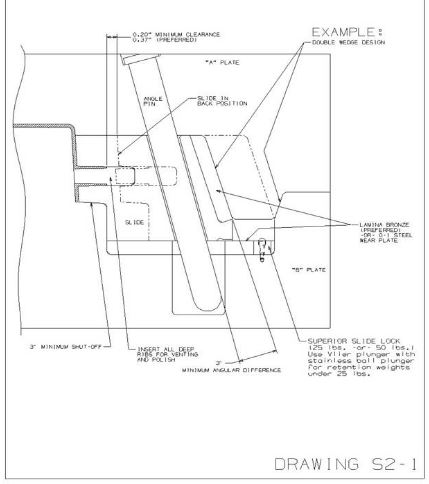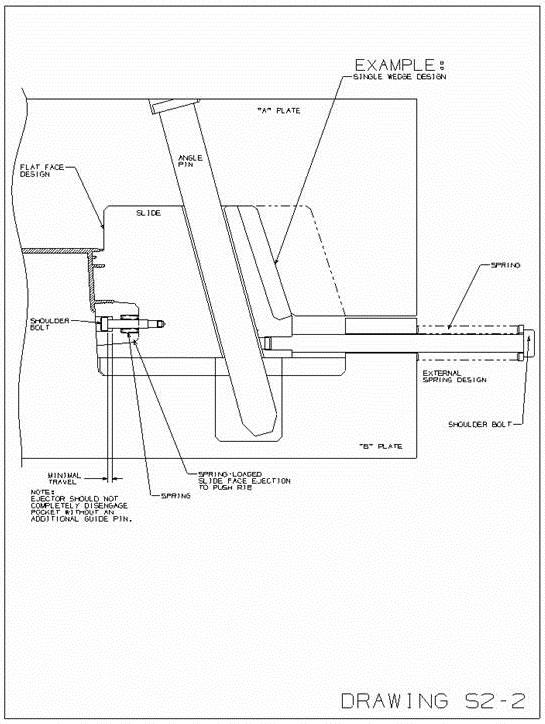1. Mechanical injection mold slider design standard (refer to drawing S2-1 & S2-2)


*All shut-off surface must have a minimum of three degrees draft in direction of slider travel. Any shut-off angle less than three degrees must have written customer approval.
*Two angle pins will be required on any slider design that exceeds seven inches in length, consider a center silder guide for all long sliders.
*There must be a minimum of three degrees difference between the angle pins and back wedge.
*The back wedge surface of the slider must have a lamina bronze (preferred) or 0-1 steel wear plate to allow for adjustment and for mainteniance of wear surface.
*The wear wedge must be designed to resist injection pressure by backing up the entire molding surface. A double-wedge design must be considered for all large molding surface.
*There must be a minimum of 0.2" (preferred 0.37") clearance between slider details and the molded part when slider is in the back position.
*There can be no injection under the slider details without written customer approval. If the customer accepts ejector under the slider detail, limit switches must register both forward and back movement of the ejector system.
*Slider that mold large areas of large part shape must have sufficient cooling. Consider Mold Max sub-inserts for difficult to cool details.
*All deep rib details must be sub-inserted for venting.
*Consider spring-loaded slide face ejection for all long wall or deep rib details.
*Superior slider locks of sufficient weight retention can be used for slider retention in the back position.
*Slider with flat faces that engage the cavity in direction of slider travel must be designed with face-loaded or external springs to prevent gaulding. In desigs with sliders on the "TOP" of mold, side-face-mounted or external spring designs are to be used instead Superior slide locks.
*There must be a minimum of 6-points hardness (RcC) between the gib material and the slider material.
*The length of the slider foot must be 50% of the overall height of the slider.
2. Hydraulic injection mold slider design standard

*All mechanical slider design standards relative to shut-off, molding surface, and cooling will apply to hydraulic slider designs.
*Parker series 2-H hydraulic cylinders will be used. The selection of cylinder bore size and cylinder mount style will be determined by slider size, amount of molding surface (injection pressure) and sequence of hydraulic pull and set. DO NOT USING PARKER MOUNTING STYLE "J" OR "JB" DUE TO THE DECREASE IN PRESSURE PATING.
*In cases where the slider rod is screwed directly into the slider body, make sure wrench flats can be easily accessed for assembly, use a double-rod-end cylinder.
*"T" style couplings can be used to secure the cylinder rod end to the slider (refer to drawing S2-3).
*Unless otherwise specified by the customer, use Parker "EPS" style solid-state proximity switches.
3. Injection mold lifter design standard (refer to drawing S2-4)

*Whenever possible use the Progressive Standard Unilifter Round Core Blade Undercut Release System with a standard Progressive head detail or a custom manufactured head detail retained to the rod portion of the assembly with a rolled dowel. All Progressive Application Guidelines must be adhered to.
*The head design of the lifter must have a minimum of three degree shut-off.
*Maximum angle acceptable for lifter travel is 11 degrees without special design considerations.
*Provide a .003" or .005" pad on top of the lifter to prevent part "drag".
*Most parts will have a tendency to "ride" with the lifters (remaining on the detail formed by the lifters), which will not left the parts fall free. In situations where there are no details/side walls to retain the parts, consider extending ejector pins into the wall section and/or add "gripper" details to the face of the ejectors (REQUIRES THAT EJECTOR PINS BE KEYED). Molded guide posts can also be considered, but must be approved by customer.
Posted by Shine


 English
English Français
Français Español
Español









